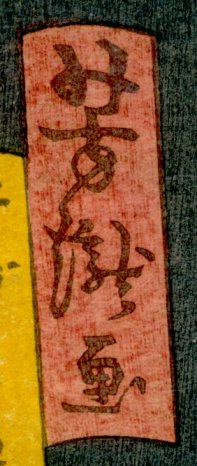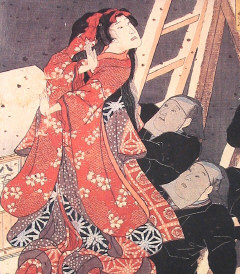 |
JAPANESE PRINTS
A MILLION QUESTIONS
TWO MILLION MYSTERIES
Ukiyo-e Prints浮世絵版画 |
|
Port Townsend, Washington |
UTAGAWA YOSHITAKI
歌川芳滝
うたがわよしたき
1841-1899
Subject: Yaegakihime Kitsunebi
八重垣姫狐火
やえがきひめきつねび
![]() Play: Honchō Nijūshi
Kō
Play: Honchō Nijūshi
Kō
本朝廿四孝
ほんちょうにじゅうしこう
![]() Actor: Arashi Rikan III
Actor: Arashi Rikan III
三代目嵐璃寛
as Yaegakihime
八重垣姫
やえがきひめ
Date:
![]() 10/1861
10/1861
Size: Chūban
中判
ちゅうばん
Print Size: 9 7/8" x 7 1/8"
![]() Publisher: Ishikawa-ya
Yasuke
Publisher: Ishikawa-ya
Yasuke
石川屋和助
いしかわや.わすけ
Signed: Yoshitaki ga
![]() 芳瀧画
芳瀧画
よしたきが
![]() There are copies of
this print
There are copies of
this print
at the Museum of Fine Arts in Boston and
at the Hankyu Culture Foundation.
SOLD!
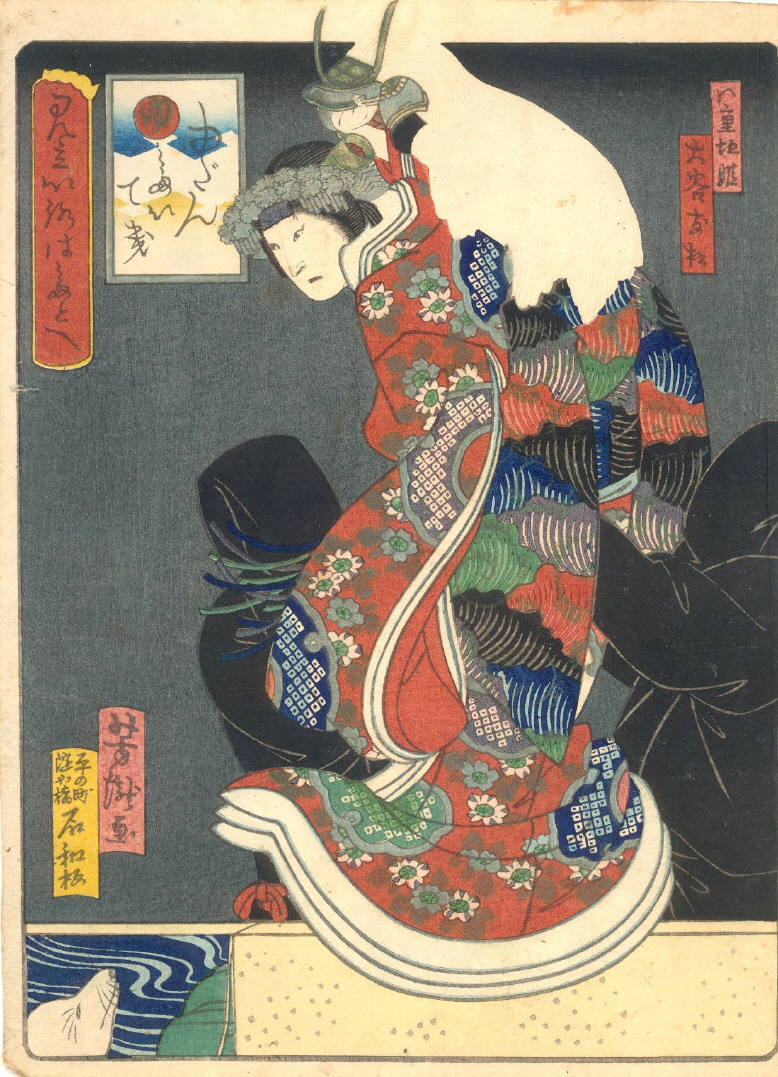
|
There is a very similar print by Yoshitaki of Yaegakihime in the collection of the Boston Museum of Fine Arts, but in that example she is shown in a snowy scene although the pose is very close.
The MFA example is dated from the 10th month of 1861. |
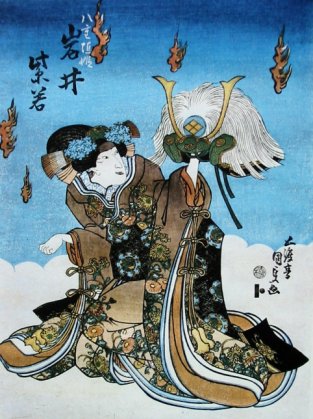
The image shown above is basically the left
panel of a diptych by Kunisada.
|
Could Use Some Help Here People! (In the past tense now.) |
|
Years ago I asked if anyone knew the exact location of a large stone sculpture of Yaegakihime holding aloft the enchanted helmet. This statue was situated in the middle of a body of water with a mountainous shoreline in the background. On February 16, 2004 our correspondent and contributor A.K. wrote and told us that it was located somewhere in Nagano prefecture and assumed that it was placed in Lake Suwa (諏訪湖 or すわこ). With this information I was able to find the exact location in the waters just off of Suwa City (諏訪市 or すわし). But I still didn't have a good photo which I could post. |
|
AT LAST - YEARS LATER |
|
Bryon C. at the University of Ohio wrote to me on October 20, 2008 to say that he had found it! See for yourself. Bryon included this URL for the Tateshina Tokyu Resort: http://www.tateshina-tokyuresort.jp/blog/2007/02/post_284.html
That sent me on an entirely new search for a decent image. I have learned a lot in the last five years about navigating the Internet. After a fairly quick look I tracked down a better photo in a web site operated by Akira Komatsu. Fortunately Akira also offered a page in English. I wrote and asked permission to use this photo and almost immediately received an answer along with a larger jpeg of the statue. (See below!) |
|
|
|
THANKS! |
|
Thank you A.K., Bryon C. and Akira. I couldn't have done this without you and consider each of your contributions significant.
One other point:
In the last 15 years I have done a lot of traveling and camping throughout the United States and Canada. I always took my mountain bike - I love my mountain bike - with me so I could explore more closely both urban and natural settings. From the crowded streets of Boston to charming or atmospheric small towns to rarely frequented forested paths where one is lucky to see five other people in a whole day I rode and rode and rode. Images like the one above make me wish I were there riding like a fiend all along the shore exploring every nook and cranny. That is what makes this picture so much sweeter: Akira Komatsu runs a bike rental shop near Lake Suwa. So, if you are in the area and have the same fever I do and no bike handy then visit Akira and I will live through your experiences vicariously. You can link to Akira's site at:
|
|
|
The foxfire or kitsunebi (St. Elmo's Fire): "Indeed, foxes are very fond of luring people to an unholy place by creating a welcoming light or 'fire', so fond that the ignes fatui are called kitsune-bi, 'fox fires'. The fire is produced by the fox striking the ground with his tail, or it may also be his luminous breath. It will either burn quietly, like a lamp, to attract the intended victim into a phantom house, or it will wander about like a torch and confuse the late traveller, sometimes ensnaring him into an inextricable forest or a swampy moor. At other times the beckoning flame will promptly extinguish at the approach of the victim, leaving him in complete darkness far away from the road. Or it may suddenly 'fly away and disappear in the sea'... The breath-exhaled fire may even 'shoot forward to the distance of some two or three feet'. . . "
Quote from U.A. Casal, "The Goblin Fox and Badger and Other Witch Animals of Japan", Folklore Studies, vol. 18, 1959, p. 10.
The above information can also be found on our Kesa thru Kuruma index/glossary page. For additonal information about flames which float freely in the air should go to our hitodama entry on out Hil thru I index/glossary page. |
|
|
|
|
|
|
|
|
|
|
|
SIGNATURE: Yoshitaki ga |
|
|
YAEGAKIHIME |
||
|
八重垣姫 |
||
|
Plays for both the puppet theater and kabuki stage would often start with an historical incident as a jumping off point. This could be as lofty as a high political drama or as commonplace as the love affair of a couple which was tragically predetermined. From there the authors would soar off into the worlds of the supernatural*, spiritual and sometimes inexplicable. Completely mixed together the initial incident could become almost totally lost and forgotten in the mix. The figure of Yaegakihime** seen above holding the spiritually imbued helmet is just such an example. |
||
|
|
|
(On the left is a detail of a bunraku print by Toyokuni III.) |
|
THE HISTORICAL CONTEXT |
||
|
The Shogun Ashikaga Yoshiteru (足利義輝 or あしかがよしてる) chose to commit suicide in his palace in Kyōto in 1565 rather than be murdered by his enemies. |
||
|
|
||
|
THE PUPPET PLAY |
||
|
“The Twenty-four Examples of Filial Piety” (Honcho nijushiko 本朝廿四孝) was written by Chikamatsu Monzaemon 近松門左衛門 (1653-1724) with the assistance of two other authors. First performed in Osaka in 1766 the play had five acts of which only two have survived. As with so many other puppet plays this one was soon adapted to the kabuki stage. |
||
|
summary of act II |
||
|
Yaegakihime 八重垣姫 is the primary figure of Act II. According to Aubrey and Giovanna Halford In The Kabuki Handbook (p.66) "The rôle of Yaegaki-hime in this act is considered one of the three most difficult 'princess' rôles of the stage."***
Act II is referred to as "The Incense Burning Scene" or Jisshiko no Ba. The Shogun has been murdered and the Takeda and Nagao 長尾, historically known as the Uesugi上杉, clans are backing the opposing sides. Yaegakihime, the daughter of Nagao Kenshin 謙信, had been betrothed to Takeda Katsuyori 竹田勝頼 who ostensibly had committed suicide on the eve of his wedding because of the enmity between the two families. In fact, he had only feigned suicide and had gotten an honorable samurai to commit the act in his stead. The samurai surrogate was the husband of the Nureginu 濡れ衣, Yaegakihime's first lady-in-waiting. Thrown into all of this high drama is a sacred helmet revered by the Takeda and which had been left in safekeeping in the hands of a shrine which handed it over to the Nagao clan. *** At the beginning of the act Yaegakihime is suffering from melancholy over the loss of her fiancé. Her Father plans an evening of koto music to raise his daughter's spirits. In the meantime, Katsuyori appears disguised as a gardener in an effort to recover his family's heirloom helmet. *** Yaegakihime and Nureginu are both seen lamenting their losses. Katsuyori remembers that this is the first anniversary of his supposed suicide. Yaegakihime begins to burn a special incense called "returning soul" before a portrait of her deceased fiancé. She promises to be faithful to him forever and implores his spirit to speak to her just once. Both women are weeping.
Nureginu leaves her room and sees the gardener. Yaegakihime looks out into the garden and sees Katsuyori believing that her "incense" prayer has been answered, but when she watches him comforting her lady-in-waiting she begins to think he is actually a sentient being. When she asks him if he is Katsuyori he denies it and swears he is only the gardener who looks like her lost love. Then Yaegakihime accuses Nureginu and the gardener of being lovers. Nureginu denies this at which point the princess indicates that she wants him for herself. Nureginu says that if her mistress truly loves the gardener then she should give him the helmet. Aha! Yaegakihime is now sure that the young man is Katsuyori who has miraculously reappeared. He denies it. She pleads for the truth, but he continues to say he is only the gardener. She pleads, he denies. Thus shunned she begs Nureginu to kill her if this is not Katsuyori. The torment is too much for all of them and the two lovers rush toward each other.**** *** Nagao Kenshin sends the gardener, whom he recognizes as Katsuyori, on a mission to deliver a letter to the other side of Lake Suwa. He then sends others with instructions to murder Katsuyori on his return journey. Since the lake has frozen over the travel must be made on foot around the lake. Yaegakihime has been listening and begs her father not to kill him. But her father demurs because he is sure that Katsuyori has come to steal the helmet. Then he drags his weeping daughter into the palace and the stage revolves. *** The helmet is shown displayed in a pavilion just off of the garden. Yaegakihime offers a prayer for Katsuyori's safety before the helmet. She lifts it from its shrine and although it is very heavy she is able to lift it easily. She takes it out into the moonlit. Holding the helmet aloft she notices that when she looks into a pond instead of the reflection of the helmet she sees the face of a fox. She sets the helmet down and stares into the pond but only sees the reflection of her own face. When she lifts the helmet again the face of the fox reappears. This is when she realizes that the helmet is possessed by fox spirits and remembers the old saw that when a fox can cross a frozen lake it is also safe for human to do so. Yaegakihime puts on the helmet and fox fires appear around her leading the way across the lake. Now she can save Katsuyori. |
||
|
|
||
|
* Modern readers or viewers of Japanese theater are often awed by the inclusion of the profusion of ghosts, spirits and elements of the supernatural. However, this does not differ greatly from the works of Shakespeare. Two plays come to mind immediately: Julius Caesar and MacBeth. In the first Caesar is warned by a soothsayer to beware the ides of March. In the second MacBeth and Banquo encounter three witches and hear their prophesies. ** “Hime” (姫) is the Japanese word for princess. *** The Halfords are referring to the kabuki adaptation from the puppet play which I have attempted to summarize above. **** Could any European opera be more dramatic? |
||
|
FUKIWA A HEADDRESS WORTHY OF A PRINCESS |
|
吹輪 |
|
ふきわ |
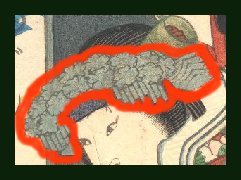 |
|
WHAT A DOLL! |
|
|
|
When I started doing research on Princess Yaegaki I ran across loads of Internet sites with dolls of this figure for sale. Some were very nice, but many were what I would describe as pedestrian. Of course, I will be the first to admit that I don't know diddly about dolls. In fact, to be honest, I may even know less than diddly about them. However, I was thinking at that time that it would be nice to be able to offer the visitors to this page a good example of this form of a good three-dimensional representation if only I could find one that I thought would be at the least acceptable. It was obvious that Yaegakihime dolls are and have been extremely popular for quite some time. There must be a good example somewhere which I could use.
I was reluctant to write to any commercial sites to see if they would let me use any of their images and would not have done so without asking permission. Then, the other day, today is November 2, 2005, a woman - Chloe T. - wrote me and mentioned that she owned a good example. We corresponded for a few days before it occurred to ask her if she could send me any images and if I liked them if I might reproduce any of them. She seemed perfectly amenable to this and sent me several pictures to choose from. Wow! The one shown above was so much more than I expected and so much better than those other run-of-the-mill ones I had seen so far. In fact, this one seems so good to me that it falls just short of 1) having it right in front of me or 2) seeing a live joruri, i.e., puppet play, production or 3) sitting in a kabuki theater with an actor playing the role. Doll connoisseurs may wince at my enthusiasm, but to me this example looks pretty damned good. And, having set it out in nature with trees and leaves as a backdrop is a particularly nice touch. |
|
|
|
Thank you Chloe T! These images make a great contribution to this page. |
|
KUROGO - MEN IN BLACK |
|
黒子 |
|
くろご |
|
One of the charms of the chuban print above is not only the puppet figure of Yaegakihime, but also the clearly visible figures dressed and hooded in black who are assisting in the performance. Nelson translates 黒子 as a prompter or stagehand. Literally it translates as "black boy." Kurogo are also referred to as Koken 後見 or こけん, assistant. (Ernst in his glossary section points out that kurogo is an alternative term for kurombō 黒奴 or くろんぼ.) (1) |
|
|
|
(1) The Kabuki Theatre, by Earle Ernst, University of Hawaii Press, Honolulu, 1998, p. 285. Nelson (5403) translates this word as negro, dark-skinned person, smut, prompter and stagehand. Mark Spahn and Wolfgang Hadamitzky in The Kanji Dictionary (4d7.2) are far less delicate with their definitions. In fact, they use the "n" word and the term darkie plus black-clad stagehand. |
|
|
|
There is a caveat somewhere in here in that Leiter states: "Bunraku puppeteers wear similar black robes and hoods." this raises the question --- for me at least --- as to whether or not these figures can be properly referred to by this term. If anyone reads this and knows I would like to hear from you. |
 HOME
HOME |

